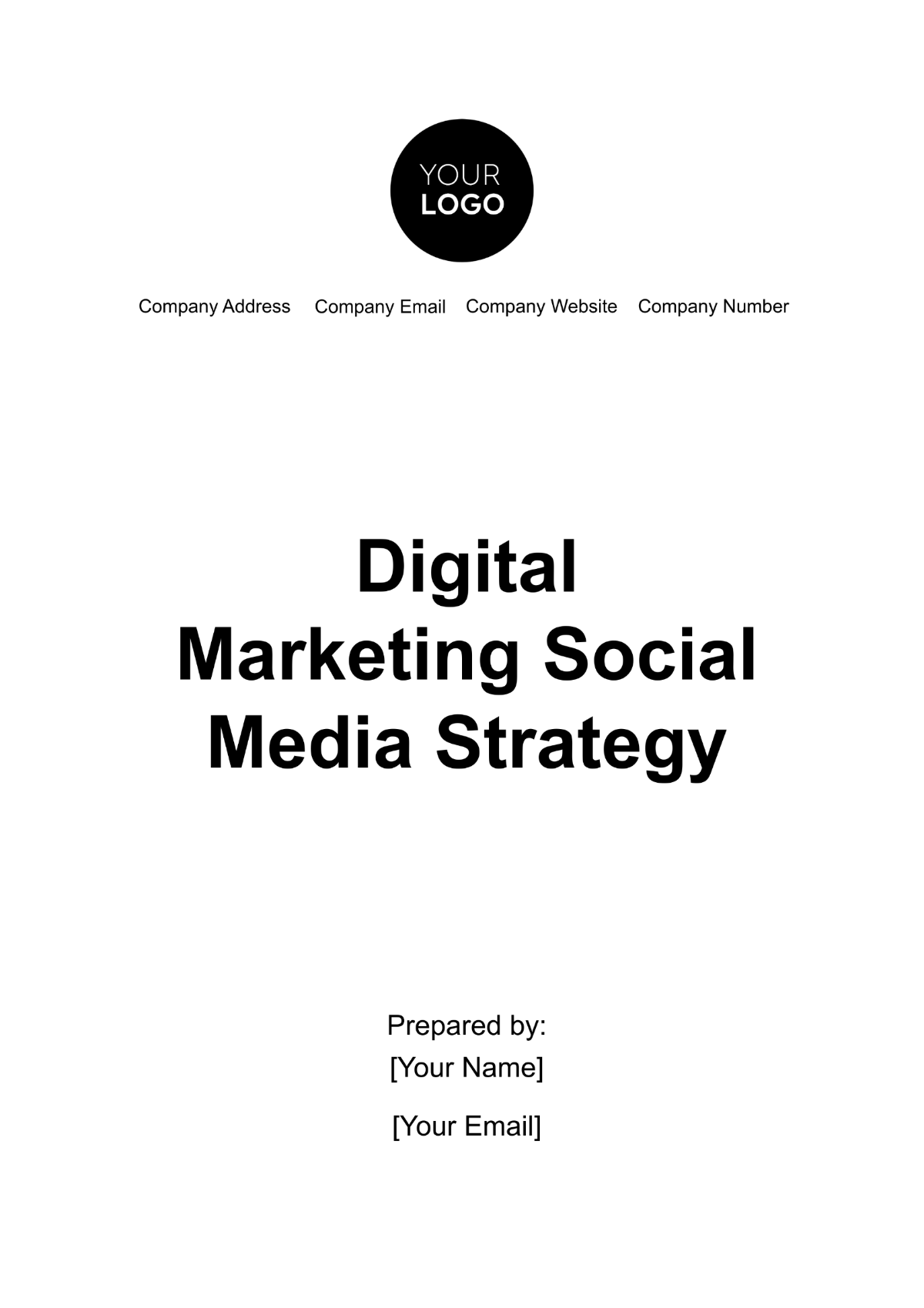Free Digital Marketing Social Media Strategy

I. Objectives and Goals
Defining clear objectives and goals is crucial for guiding [Your Company Name]'s social media efforts and measuring success. This section outlines specific targets that align with [Your Company Name]'s overall business strategy, ensuring that social media activities are purposeful and contribute to achieving broader marketing objectives.
Goal
Increase brand visibility and engagement across key social media platforms by setting measurable targets to drive growth and achieve [Your Company Name]'s business objectives.
Objectives
Boost brand awareness by increasing social media followers by 20% within 6 months.
Drive website traffic by generating a 25% increase in referral visits from social media channels.
Enhance user engagement by achieving a 15% increase in average post interactions over the next quarter.
II. Target Audience
Understanding your target audience is fundamental to crafting an effective social media strategy. This section delves into the demographics, interests, and behaviors of [Your Company Name]'s ideal customers. By identifying and analyzing who your audience is and where they engage online, you can tailor your content and messaging to resonate with them. This ensures that your social media efforts are not only seen but also engage and convert the right people, driving meaningful interactions and achieving your marketing goals.
Target Audience
Demographics: Age, gender, location, income level, and education.
Interests: Hobbies, lifestyle preferences, and areas of interest related to your products or services.
Behaviors: Online activities, purchasing habits, and social media usage patterns.
Pain Points: Common challenges or problems that your products or services can address.
Social Media Platforms: Preferred platforms where they are most active (e.g., Facebook, Instagram, LinkedIn).
III. Social Media Platforms and Tactics
Selecting the right social media platforms and implementing effective tactics are essential for reaching [Your Company Name]'s target audience and achieving marketing goals. Each platform offers unique features and audience segments, which should be leveraged to maximize impact. Tailoring your approach to each platform ensures that your content resonates with users and drives engagement.
The following table outlines the key social media platforms, associated tactics, and best practices for [Your Company Name]. By utilizing this table, you can create a targeted strategy that aligns with the strengths of each platform and effectively engages your audience.
Platform | Tactics | Best Practices |
|---|---|---|
|
| |
|
| |
|
| |
|
| |
TikTok |
|
|
IV. Content Strategy
Crafting a compelling content strategy is key to engaging [Your Company Name]'s audience and achieving social media goals. A well-defined strategy ensures that content is relevant, consistent, and aligned with the brand’s voice. It involves planning the types of content to be shared, setting a publishing schedule, and determining how to engage with the audience.
Effective content should cater to the interests and needs of your target audience while also aligning with broader marketing objectives. This includes utilizing various content formats and distribution channels to maximize reach and impact. The following elements are crucial for developing a robust content strategy:
1. Content Themes: Identify core themes that resonate with your audience and reflect your brand values. These could include industry insights, company updates, educational resources, or entertainment.
2. Content Formats: Utilize diverse formats such as articles, infographics, videos, and interactive posts to keep the audience engaged. Adapt content to suit the preferences of different platforms.
3. Content Calendar: Develop a schedule for posting content to ensure regular and strategic engagement. A content calendar helps in organizing and planning content in advance, keeping the strategy on track.
4. Brand Voice and Messaging: Maintain a consistent tone and messaging that reflects [Your Company Name]'s brand identity. Ensure that content is aligned with your company’s values and resonates with your audience.
5. Engagement and Interaction: Plan for how you will interact with your audience through comments, messages, and other forms of engagement. Building relationships and responding to feedback is crucial for fostering a loyal community.
6. Performance Analysis: Regularly review the performance of your content using analytics tools. Track metrics such as engagement rates, reach, and conversions to evaluate effectiveness and make data-driven adjustments.
V. Metrics and KPIs
Measuring the success of [Your Company Name]'s social media efforts requires establishing clear Key Performance Indicators (KPIs). These metrics help in evaluating the effectiveness of your strategy and making informed decisions. By tracking the right KPIs, you can understand how well your social media activities are performing and identify areas for improvement.
KPI | Definition | Importance |
|---|---|---|
Engagement Rate | Measures the level of interaction (likes, comments, shares) relative to the number of followers or impressions. | Indicates how well your content resonates and fosters meaningful interactions. |
Click-Through Rate (CTR) | The percentage of users who click on a link within your post compared to the total number of users who view the post. | Assesses the effectiveness of your calls-to-action and content relevance in driving traffic. |
Conversion Rate | The percentage of users who take a desired action (e.g., purchase, sign-up) after interacting with your content. | Measures the success of social media efforts in generating leads or sales. |
Follower Growth | Tracks the increase or decrease in the number of followers over a specific period. | Reflects the growth of your social media presence and effectiveness in attracting new audience members. |
Reach and Impressions | Reach measures the unique users who see your content, while impressions track the total number of times content is displayed. | Gauges content visibility and the size of your audience. |
Share of Voice | Measures how often your brand is mentioned compared to competitors within social media conversations. | Provides insight into brand awareness and impact relative to industry peers. |
Utilize this table to track and analyze the performance of [Your Company Name]'s social media activities, ensuring continuous improvement and alignment with your marketing goals.
VI. Compliance and Legal Considerations
Ensuring that [Your Company Name]’s social media activities comply with legal standards is essential for protecting your brand and maintaining trust with your audience. Adhering to regulations helps avoid legal issues and fosters a positive online presence. Below are key compliance and legal considerations:
1. Advertising and Promotional Guidelines
Adhere to Federal Trade Commission (FTC) regulations for advertising and promotions. This includes clear disclosure of any material connections between your brand and influencers or endorsements. Transparency in advertising prevents deceptive practices and builds consumer trust.
2. Data Protection and Privacy
Comply with data protection laws such as the General Data Protection Regulation (GDPR) and California Consumer Privacy Act (CCPA). Ensure that personal data collected through social media is handled securely, with explicit user consent for data collection and processing. This safeguards user privacy and mitigates risks associated with data breaches.
3. Intellectual Property Rights
Respect intellectual property laws by avoiding the use of copyrighted material without permission. Ensure all content shared is either owned by [Your Company Name] or properly licensed. This prevents legal disputes and protects your brand’s content integrity.
4. Platform-Specific Policies
Follow each social media platform’s terms of service and community guidelines. Compliance with platform rules is crucial to avoid account suspensions and maintain a positive brand image.
5. Accessibility and Inclusivity
Ensure that your content is accessible to users with disabilities by following web accessibility standards. This includes providing alt text for images and ensuring content is compatible with screen readers, promoting inclusivity and broadening your audience.
6. Content Moderation and Legal Risks
Implement clear content moderation policies to manage user-generated content and prevent harmful or illegal material. Address potential legal risks such as defamation or hate speech to maintain a respectful and safe online environment.
By addressing these considerations, [Your Company Name] can navigate the legal landscape effectively, ensuring compliance and enhancing its online presence.
A well-structured Digital Marketing Social Media Strategy is vital for [Your Company Name] to achieve its marketing objectives and engage effectively with its audience. By setting clear goals, understanding your target audience, leveraging the right platforms, crafting compelling content, tracking performance with KPIs, and adhering to legal standards, you can drive meaningful results and build a strong, compliant social media presence.
- 100% Customizable, free editor
- Access 1 Million+ Templates, photo’s & graphics
- Download or share as a template
- Click and replace photos, graphics, text, backgrounds
- Resize, crop, AI write & more
- Access advanced editor
Elevate your online presence with the Digital Marketing Social Media Strategy Template from Template.net. This editable and customizable template helps you plan and execute effective social media campaigns. Fully editable in our Ai Editor Tool, it offers a professional and structured format to optimize your social media strategy for better engagement and results.
You may also like
- Instagram Ad
- Instagram Banner
- Instagram Frame
- Instagram Post
- Instagram Profile Picture
- Instagram Story
- Instagram Story Highlights
- Twitter Ad
- Twitter Header
- Twitter Post
- LinkedIn Photo
- Linkedin Post
- YouTube
- Youtube Ad
- Youtube Banner
- YouTube Channel Art
- YouTube End Screen
- Youtube Profile Photo
- YouTube Thumbnail
- Facebook Ad
- Facebook Cover
- Facebook Post
- Facebook Profile Frame
- Facebook Profile Photo
- Twitch Offline Banner
- Linkedin Banner
- Twitch Overlay
- Whatsapp Status
- Reddit Banner
- Social Media Banner
- Social Media Clipart
- Social Media Plan
- Social Media Contract
- Social Media Planner
- Social Media Report
- Social Media Agreement
- Social Media Business Card
- Social Media Proposal
- Social Media Presentation





























